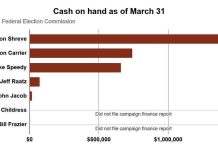The familiar A through F grading system will change this school year for some Bartholomew Consolidated School Corp. elementary students.
Growth model reporting is being introduced in all kindergarten through third grade classes this fall, the school corporation announced.
Growth model reporting evaluates student progress based on a scale of 1 to 4, where 1 represents performance below grade level, and 3 represents a mastery of grade level standards. Students can also earn a 4, but such a score would mean a student is consistently performing above grade level standards, an accomplishment that will likely be rare, said Laura Hack, BCSC director of elementary education.
Growth model report cards will not provide just one score for a subject but instead will evaluate students based on several subcategories within each subject. For example, scores in reading will be broken down into skill sets such as fluency, comprehension, organization and vocabulary, while math will be broken down into areas including problem solving and math facts.
The idea of growth model reporting is to give a more detailed look at how students are faring with different academic standards so that parents can then work with their children one-on-one in the skill sets where they may need some extra help.
“It’s not just giving them a report card and saying, ‘This is how you did,’ it’s saying, ‘This is how you’re doing,’” said Darin Sprong, Richards Elementary School principal.
Hack described the growth model reporting system as a mind shift for students, teachers and parents alike, who will have to stop thinking in terms of the finality of the A to F system and instead will have to learn to view a growth model report card as a live, fluid document that can provide information about student progress at any time.
Growth model report cards will not take into account skills such as attendance, respect and turning in homework, Hack said.
Those skills will still be assessed, but they will not factor into a student’s subject scores, Hack said. Instead, growth model reporting scores will only assess student progress in actual academic subjects so that parents have an accurate understanding of how their students are progressing in basic foundational subjects such as math and reading, she said.
The most important thing to remember is that an A in the standard grading system is not the equivalent of a 4 in growth model reporting, Sprong said. Recognizing that the two grading systems are not comparable is the first step in understanding how the growth model system works, he said.
Early in the school year, students will be assessed in the various subcategories to determine their baseline scores, Sprong said. Those scores might initially only be 2s, but Sprong said that is to be expected because a score of 2 means a student is approaching the grade level standard.
Then, as the school year progresses, students will be continually assessed, and their scores continually updated. Each quarter students will receive new scores, with the goal of all students earning a score of 3 in all subjects by the end of the fourth quarter.
Using a growth model reporting system lets students to take control of their own learning by allowing them to see their progress in real-time, Sprong said.
For example, if a student knows they have mastered reading fluency but not organization, they can spend more time on their own trying to improve their reading organization skills to earn a score of 3 for that subcategory.
Parents also appreciate the unique approach to student assessment, said Brett Boezeman, Schmitt Elementary School principal.
Boezeman said he worked with a core group of parents last year to get feedback on how effective they found the growth model reporting system to be. As they learned more about it, the parents said they appreciated the opportunity to know more about their children’s progress in specific areas so that they could work with their children in the trouble areas one-on-one at home.
While all kindergarten through third-grade classrooms will use growth model report cards this year, Richards and Schmitt elementary schools will also pilot the fourth-grade model.
Sprong and Boezeman said their fourth-grade teachers spent all of last year working to develop the various standards that would be evaluated and measured with growth model reporting based on the skills students will need to succeed going into fifth grade.
The fourth-grade teachers took ownership of creating the new grading system because they were passionate about finding new ways to ensure students success, the principals said.
Although the fifth- and sixth-grade program has not been developed yet, Sprong said his teachers in those grades are already anxious to begin developing their new approach to student evaluations.
The district’s goal is to pilot growth model report cards in fifth and sixth grade by the 2017-18 school year.
[sc:pullout-title pullout-title=”Growth model reporting grading scale” ][sc:pullout-text-begin]
With the growth model reporting system, student progress in various academic standards could receive the following scores:
1: Below grade level standard
2: Approaching grade level standard
3: Mastery of grade level standard
4: Exceeds grade level standard
At the beginning of the school year, students may only earn a score of 2 in the various subcategories, but the goal is for all students to earn scores of 3 by the end of the fourth quarter.
[sc:pullout-text-end]




